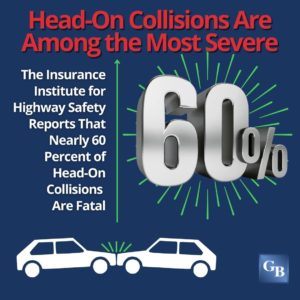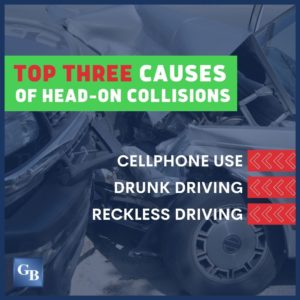Head-On Collisions
A head-on collision occurs when two cars traveling in opposite directions crash. Head-on car accidents are very serious and devastating because there is rarely enough time for a driver to react when they see a car heading straight for them. Both parties can be seriously injured or even killed.
Like many car accidents, most head-on collisions could have been prevented, as they are most often the result of a negligent driver. The following are common causes of head-on collisions.
Distracted Driving 
Distracted driving is anything that takes a driver’s hands off the wheel, eyes off the road, and attention off driving, including the following distractions:
- Cellphone use: Cellphones enable us to talk, text, get directions, send emails, take pictures, and more. Unfortunately, some people do these things while driving, causing accidents and deaths.
- Rowdy passengers: Loud music, yelling, horseplay, and many other behaviors can cause driver distraction and potential accidents. Teen and young adult drivers are especially prone to having rowdy passengers in their cars.
- Eating and drinking: Many people will grab a meal at the drive-thru and continue on their way, not thinking that eating and drinking can be distracting until it is too late.
- Fooling with controls: Turning on the heat, finding a radio station, moving the seat, programming the GPS, and similar actions cause a driver to look down or otherwise away from the road. They can cross the center line in a second, plowing straight into an oncoming car.
- Getting lost in thought: Sometimes, you can get lost in thought or begin to daydream, especially on a long highway trip. You need to keep focused on the road at all times.
Drowsy Driving
It is well-documented that most Americans lack adequate sleep. A fatigued driver is an unsafe driver, causing a delay in reaction time or leading to a driver falling asleep at the wheel. A front-end collision is often the result of a driver nodding off for a second or falling fully asleep.
Impaired Driving
Drivers who get behind the wheel after drinking or using drugs are a common cause of serious injuries and deaths on the road. An impaired driver cannot usually stay in their lane and may head straight for a car coming in the opposite direction.
Improper or Illegal Passing
A driver may completely ignore signs and road markings that indicate passing is not allowed, or they may not know if passing is allowed. They may try to pass the car ahead of them and meet oncoming traffic with no time to react.
Reckless Driving 
Reckless driving is a danger to any motorist in the path of this type of driver. Reckless drivers will often pass illegally or unsafely or weave in and out of traffic, making them liable for causing a head-on crash.
Car Failure
Sometimes, a car’s brakes, steering, or other systems fail, rendering a driver unable to control their vehicle. A front-end crash is a real possibility when this happens.
Driver Confusion
A driver may not realize they are going the wrong way on a one-way street or on a freeway ramp or the freeway itself. Whatever their reason for being confused, the result can be deadly.
Speeding
Speeding is harmful no matter where one is driving. A driver who needs to quickly react while speeding will most likely skid, sometimes right into the path of an oncoming car.
Weather Conditions
When it is rainy, foggy, snowy, or icy, drivers must change their driving for the weather conditions. Many do not and can easily hit a patch of ice, snow, or wet road and go skidding from their lane into the path of an oncoming car.
Swerving
Sometimes, a driver will swerve to avoid an animal or debris in the road or to avoid hitting a driver who abruptly stopped in front of them. Whether or not the swerve is innocent, it is still reckless if it causes a head-on or other types of collisions.
 Google Screened
Google Screened
